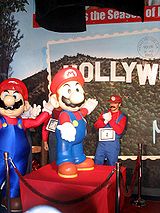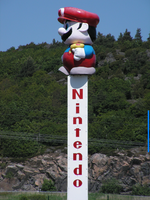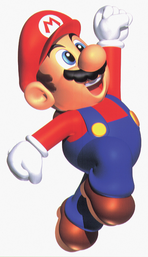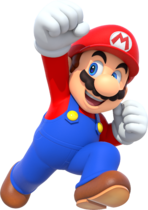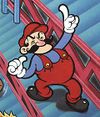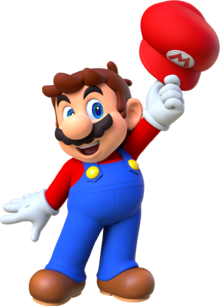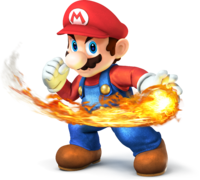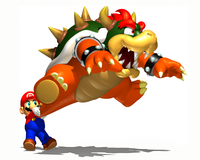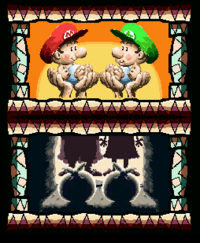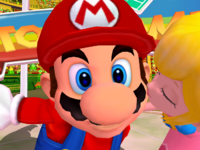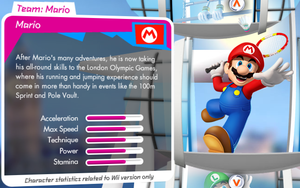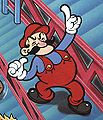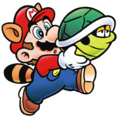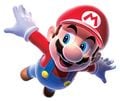MarioWiki:Sandbox: Difference between revisions
(→History: I'm tired of removing the sections, so I decided to remove this entire section) |
|||
| Line 705: | Line 705: | ||
*The 1993 Nintendo Character Guide classifies Mario under the species "''homo<sup>[sic]</sup> nintendonus''".<ref>Devore, Jordan (August 5, 2014). [http://www.destructoid.com/yoshi-is-properly-known-as-t-yoshisaur-munchakoopas-279145.phtml Yoshi is properly known as T. Yoshisaur Munchakoopas]. Destructoid.</ref> | *The 1993 Nintendo Character Guide classifies Mario under the species "''homo<sup>[sic]</sup> nintendonus''".<ref>Devore, Jordan (August 5, 2014). [http://www.destructoid.com/yoshi-is-properly-known-as-t-yoshisaur-munchakoopas-279145.phtml Yoshi is properly known as T. Yoshisaur Munchakoopas]. Destructoid.</ref> | ||
*According to the Insiders' Calendar included in the second issue of ''[[Nintendo Power]]'', Mario's birthday is October 11th. | *According to the Insiders' Calendar included in the second issue of ''[[Nintendo Power]]'', Mario's birthday is October 11th. | ||
Revision as of 00:58, July 19, 2017
The sandbox (MarioWiki:Sandbox) is a wiki namespace page designed for testing and experimenting with wiki syntax. Feel free to try your skills at formatting here: Click on edit, make your changes, then click "Save changes" when you are finished. Content added here will not stay permanently. Feel free to remove any content when you think this page gets too crammed. This is not a page to chat.
Please do not fill the sandbox with memes. A little joking is fine, but if the sandbox is oversaturated with memes or jokes unrelated to testing, the jokes and memes in the sandbox will be removed. If you need further help editing, visit our help page.
- This page is about the main character of the Mario franchise. For the overall franchise, see Mario (franchise). For the portrayal of Mario in the Super Mario Bros. film, see Mario (film character).
- "Jumpman" redirects here. For the badge of the same name, see Jumpman (badge). For the Donkey Kong minigame from Mario Party 7, see Jump, Man.
- “It's-a me, Mario!”
- —Mario, Super Mario 64
Mario is the main character and protagonist of the long-running and highly successful Mario franchise. He was created by Japanese video game designer Shigeru Miyamoto and also serves as the main mascot of Nintendo. Mario made his first appearance as the protagonist of the arcade game Donkey Kong, released in 1981. Since Super Mario Bros., his trademark abilities have been his jumping and stomping powers, with which he defeats most of his enemies; and his ability to gain powers with a plethora of items, such as the Super Mushroom, Fire Flower and the Super Star. Games have usually portrayed Mario as a silent character without a distinct personality (Fortune Street is a notable exception). According to Nintendo's philosophy, this allows Mario to fit in many different genres and roles. In most games, he is the hero that goes on an adventure to save Princess Peach from Bowser, but he has been shown doing many other activities besides adventuring, such as racing and sporting with his younger twin brother and others.
Cultural impact
Mario is often said to be the most famous video game character in history. A Q Score survey made in the early nineties showed Mario was even more popular than Mickey Mouse[1], and he has the only wax statue of a video game character, which stands in the Hollywood Wax Museum.
The Mario series is the best-selling video game franchise in history; the sales include 463.87 million, whereas the next best-selling franchise, Pokémon, totals 245 million. Even with subseries excluded, the main Mario series has sold 262 million games (as of March 2011).[2] Furthermore, Mario is the flagship series of Nintendo and Mario is the company's mascot, furthering his publicity even more. According to the Guinness World Records’ 2008 edition, Mario has appeared in a total of 116 separate games, which is more than any other video game character[3] and more recent sources such as the Game On 2.0 travelling exhibit place the number at over 200.[4]
General information
Physical description
Mario's distinctive look is due to technology restrictions in the mid-1980s. With a limited number of pixels and colors, the game developers, including Mario's creator, Shigeru Miyamoto, could not animate Mario's movement without making his arms "disappear" if his shirt was a solid color, so they gave Mario overalls. The developers additionally did not have the space to give him a mouth, the result of Mario's mustache. Finally, they used a cap to bypass the problem of animating and drawing hair.
Mario has underwent major changes since his initial appearance in Donkey Kong up until Super Mario Bros.. Although he has the general features such as the clothing and the mustache, it is not until Super Mario Bros. where he resembles as he is today. In Donkey Kong, Mario appears lankier with a more-realistic-looking red nose. In some portrayals in Donkey Kong Jr., however, he appears stouter with a round nose, which resembles more closely to Mario's current design, although some promotional art retain Mario's original Donkey Kong design. The stubbier design is retained in Mario Bros., with a few changes.
Since Super Mario Bros., however, Mario is depicted as a stocky young man, though he was originally imagined as middle-aged. His age has been approximated to be about 26 years old[5], while Shigeru Miyamoto later placed it at either 24 or 25.[6] Mario wears a trademark cap, brown hair (although the DiC cartoons sometimes depict it as black), black or dark-brown mustache and overalls who is 155 cm (5 ft, 1 in) tall.[7] A contradicting source, however, has crossover artwork depicting Sonic the Hedgehog (who stands at 3'3") to be at least two or three inches taller. Merchandise for the original Donkey Kong showed Mario as balding, although most media depict Mario with a full set of hair. The most notable change Mario has received over the years since Super Mario Bros. (omitting stylistic variations such as depictions in Paper Mario) is his change in stature; Mario is shown to be much stubbier in his earlier appearances compared to his more recent appearances, starting with Super Mario 64. Mario's legs and arms have grown longer over the years, giving him a slimmer look. This may have been the result of Shigeru Miyamoto's response to their "cute" appearances, who considered redesigning them to "become a bit more grown-up" in the GameCube era, for instance by removing their trademark V sign.[8]
Mario from his Super Mario 64 appearance is depicted with darker blue overalls and bigger eyes than in his current appearance based from the one in Luigi's Mansion. He has a slightly darker skin and his ears are also rounder. His overall straps are longer and his cap is less round. Mario is overall less defined in the game artworks of the time due to the older software used to design him. The differences in Mario's 3D art over time, as a result, is more pronounced than the differences in Mario's 2D art since Super Mario Bros.. Ever since Luigi's Mansion, however, Mario has received only minor changes to his general appearance, such as added detail in his shoes, eyes and cap emblem in most game artworks since Super Mario 3D World.
Mario has a few stylistic variations across some games, sometimes within series. One variation is Mario's overall appearance in Paper Mario games is generally the same, with black dots for eyes and no eyebrows, although he has a shorter stature. Since Paper Mario: The Thousand-Year Door, however, Mario's body is more simplistic, with legless feet, a rounder face and a full outline around the arms. Another variation is Mario's depiction in the Mario & Luigi games, although it is more subtle, where Mario is given black eyes rather than blue.
Clothing
Mario is typically shown wearing his trademark outfit wherever he goes. He has a long-sleeved red shirt (short-sleeved in Super Mario Sunshine) which is tucked under a pair of white gloves and has a noticeable collar at the neck. Layered over the shirt is a pair of blue overalls with yellow buttons. On his feet is a pair of light brown work shoes. In the Paper Mario series, these are known as boots and it is shown to have a rim on the top, although Mario's shoes in most media do not have this rim. In Super Smash Bros. Melee and Super Smash Bros. Brawl, Mario's dungarees are more realistic, resembling denim, and have additional details such as back pockets.
Originally, Mario wore red overalls on top of a blue shirt - nearly the opposite colors of what he wears now. The Famicom version of Mario Bros. is the first game to depict Mario with blue overalls and a red undershirt (although on the boxart, he is depicted entirely in blue), but Super Mario Bros. 2 standardized Mario's current colors.
Mario's trademark is his red cap with his red "M" insignia. Mario's cap is sometimes an important and even mandatory accessory in some games, such as in Super Mario 64, where he takes more damage without his cap. In Super Mario Sunshine, if Mario loses his cap, he will acquire damage over time from the heat of the sun. In most media, however, Mario's cap is treated as a mere accessory and Mario can go capless in some games without any additional effect, such as in New Super Mario Bros. Wii. In some games, such as in Super Mario 3D Land, if Mario is in small form, he is seen without his cap, although it is no different from the other incarnations of the small form. In Super Mario Odyssey, Mario's default cap is replaced with Cappy, which can be replaced with other caps or hats in the Crazy Cap stores as well.
Mario has seen some variations to his outfit in the games. In Super Mario Sunshine, for instance, Mario has shorter sleeves. In addition, Mario can wear a tropical shirt over his normal shirt, along with sunglasses that darkens the screen, if he talks to the Sunglasses vendor. Mario also usually gains alternate outfits when using powerups, from simple recolors to covering his whole body such as Fire Mario, Tanooki Mario, Propeller Mario, Flying Squirrel Mario and Cat Mario. Finally, Mario can resemble different characters, even outside the Mario series by using a Mystery Mushroom to change into one of the various forms of Costume Mario in Super Mario Maker. Mario is shown to be able to wear different costumes and outfits from the Crazy Cap stores in the upcoming Super Mario Odyssey.
Although mostly seen with his default plumber attire, Mario has also worn several alternate outfits in the spin-off games including, but not limited to Dr. Mario, the Mario Strikers games, Mario's Picross and NES Open Tournament Golf.
Name
Mario's full name is given as "Mario Mario" in the Super Mario Bros. movie. In a few isolated cases, this has leaked into other media - for instance, the Prima guide book for Mario Party 2 lists his name as Mario Mario in a note section.[9] The Prima guide for Mario & Luigi: Superstar Saga similarly shows Mario's full name as Mario Mario in the list of major characters.[10] Also, when people asked Mario (voiced by Charles Martinet) what his last name was, he had responded with this: "My name's-a Mario Mario. Of course, my brother's name, a-Luigi Mario. And of course, my mama's-a Mama Mia Mario; my papa Papa Pio Mario. Of course, my grandmama Grandmama Mia Mario and my greatpapa et cetera, et cetera. Yeah, first name Mario, last name Mario. Yahoo!".[11] However, Nintendo of America has stated that "there are no last names."[12][dead link] This was also recently confirmed by then-Nintendo president Satoru Iwata.[13] In the games, additionally, Shigeru Miyamoto has stated that both Mario and Luigi's last names are anonymous and do not relate to their last names in the movie as seen above, although he has recently redacted that stance, stating at the Super Mario Bros. 30th Anniversary festival in September 2015 that Mario and Luigi's last names are indeed "Mario".[14]
Personality
Mario is known for being kind, cheerful, playful, courageous and headstrong and is also eager and cocky in certain occasions. Officially, however, Nintendo producers have stated that Mario's biography is kept simple in order to make the character versatile and reusable in many different games and situations. Mario is indeed one of the most underdeveloped characters in the Mario series. In fact, his brother Luigi has even gained a bit more of a personality in recent games. In most media and some games, though, Mario is depicted as an Italian plumber from Brooklyn [15] who stands for what is right and has a love for Italian food. Mario has proven himself to be a competent fighter, all-around sports player and party lover in Mario spin-off titles. Mario shows generally good sportsmanship for his wins and losses, even complimenting his opponent if he fails to be first, such as instances in Mario Kart 8 and Fortune Street. At a few other times, however, such as in Mario Kart 64, he is shown wiping a tear and in Mario Golf: Toadstool Tour, he throws a small fit. Finally, it has been said that Mario loves animals, especially the most unusual ones,[16] and he also enjoys music, particularly opera or new-wave Europop[16] although there is no further comment for these statements.
Mario has been shown on very occasions, such as certain cutscenes in Mario Power Tennis, but often in Super Mario-Kun, to have an almost overbearing attitude towards his brother. However, this could also just be Mario's outgoing "big brother" personality interacting with Luigi's more introverted nature. Additionally, Mario is much more impulsive and aggressive than his brother Luigi and is willing to enter dangerous situations all alone. Mario will often attempt to quickly solve a problem with his actions. Mallow even had to physically restrain Mario from brawling several times, such as before the battle with Bowyer, so that the heroes could figure out what exactly was happening to their world. While Mario will accept help and even partners during his adventures, at times he may also resent the implication that he needs the help in the first place. Despite this, he seems to enjoy their company. In the Super Mario-Kun, Mario is short-tempered and he resorts to yelling at his friends for failing or making uncalled-for actions. In Super Mario-Kun, Mario is not above in certain vulgar actions, such as farting to taunt his opponents or urinating on Yoshi and he also cross-dresses several times. The title itself and the artstyle of the Super Mario-Kun manga also depicts Mario with a childish personality. "Kun" is a generally masculine Japanese honorific for juniors such as boys or teenagers.
Mario seems to have a small fixation with food. This is most notably seen in the DiC cartoon trilogy, which may also be the origin of this trait, where Mario is almost constantly hungry and fascinated with Italian food (mostly pizza and pasta), typically wanting to stop Bowser's latest scheme simply so he could eat and going to nearly any length to do so. In fact, in the The Super Mario Bros. Super Show! episode "Koopenstein", when Princess Peach asked him if he ever thought about anything besides food, Mario, with pure honesty, replied, "What else is there?" As in Super Mario 64 and its remake, the original reason Mario came to the castle is that Peach was baking him a cake, which becomes a recurring trend in future games, such as in Super Mario Galaxy 2 and New Super Mario Bros. Wii, although Mario, as well as his friends, has also fallen for false invitations to a big feast, shown in Mario Party DS. In the opening of Super Mario Sunshine, Mario is apparently daydreaming about seafood. In Fortune Street, he offers Yoshi to help by finding Yoshi's cookies, but before playfully saying, "just give me a second to brush these cookie crumbs out of my mustache!" Quite a few characters in other games also advised Mario to refrain from eating much. For instance, when Mario holds to Hoot for too long, Hoot may complain about Mario's eating habits before exhausting and letting him go. Additionally, the Star Gate from Mario & Luigi: Partners in Time, while praising Mario for his pure heart, has criticized his diet, advising him to limit the Alfredo sauce and carbora in tandem with more exercising.
Speech
Like many other protagonists of Nintendo games, Mario rarely speaks, his dialogue primarily limited to numerous grunts and yells. When he does speak, he speaks English with a heavy Italian accent, often referring himself to the third person. In most games, with Charles Martinet's, his most recurring voice actor, voice-overs, Mario's voice is soft and high-pitched, but in a few other games and in the cartoons, Mario has a gruff voice usually associated with a Brooklyn accent. In the Mario vs. Donkey Kong titles, Mario speaks fully, shouting sentences such as "Come back here, you big monkey!" He can be clearly heard shouting, "Welcome! Welcome, new galaxy!" in the ending of Super Mario Galaxy, as well as saying "Thank you so much for playing my game!" after the credits. Mario has also been shown full capable speech in Itadaki Street DS and Fortune Street. Despite Nintendo's emphasis on Mario as a silent protagonist, Mario is the most often heard speaking in full sentences, if occurrences outside the games (especially in special events in real life) are counted.
In some cases, Mario is a true silent protagonist, or he does not speak in English. In Super Mario RPG: Legend of the Seven Stars, Mario is completely silent, communicating solely through pantomime. In the Paper Mario titles, he mainly communicates through simple nodding and hand gestures; while he is completely silent in Paper Mario, however, he is given grunts in the latter games. Mario is also silent during dialogue scenes in the Mario Baseball and Mario & Sonic series, although he can technically talk. In the Mario & Luigi titles, he and Luigi speak in unintelligible gibberish that the other characters can understand. In Super Mario Sunshine, Mario is "heard" speaking in the opening scenes, but his dialogue is completely inaudible, although this is present only in the American version of the game. In other versions, Mario is heard speaking coherently, such as saying "Looks like Mario's gonna have to find a job!" to Toadsworth after landing on Delfino Airstrip.
He has full speech capabilities in some sports games and outside games (including when being portrayed in real life) and also speaks regularly in the DiC cartoon trilogy, though he speaks perfect English with a Brooklyn accent in the latter. In a press conference, Mario is shown to be able to speak in full sentences.[17] Also, people can communicate with Mario by asking various questions; there, too, Mario can fully speak, although his Italian accent mostly disappears.[11][18][19] In the games, other characters speak for him, mainly Lakitu and Toad.
Powers and abilities
Mario's most notable ability is his Jump, which is his basic move he relies on to defeat enemies, avoid obstacles and activate helpful items such as ? Blocks and P-Switches. Although Luigi has superior jumping, Mario is more well-known. He is also capable of several acrobatic maneuvers, including the Long Jump, Back Flip, Spin Jump and Wall Jump, with the Wall Jump being one of his most recurring abilities. Mario can also use a variety of basic martial arts attacks, including punching and kicking, although he uses these moves the most in Super Smash Bros. games; in most games, jumping is his main form of attack. Mario's main weapon is the Hammer in Donkey Kong, although Mario often uses the Hammer as a weapon in Mario RPGs.
Mario is usually associated with fire in the the spin-offs, based on his Fire Mario form from Super Mario Bros. Mario can, in some games, such as Super Mario RPG: Legend of the Seven Stars, control fire without a Fire Flower power-up, although the first game where he actually starts using this power regularly is Super Smash Bros. Melee.
Mario has been shown to possess superhuman strength. In Super Mario World, he is seen lifting a fortress out of the ground and then kicking it away. In Super Mario 64, he can carry and throw King Bob-omb, although with some difficulty. During the battles with Bowser; Mario can grab him by the tail, spin him and throw him. His strength is also shown in Super Mario Galaxy, where he can easily stun a Mega Goomba with a Star Spin despite its great size and his ability to knock Bowser around during battles with him. In Bowser's Inside Story, although he is visibly straining, he is able to lift and throw a swelled Luigi when using the Snack Basket move. In the spinoffs, Mario, although usually balanced, boasts generally slightly higher-than-average power.
Mario has been designed to be a versatile character deliberately. As a result, whenever he appears in a game, his emphasis is always, in both spinoffs and mainstream games, a balanced playstyle, allowing him to participate and perform well in many situations. Indeed, his bios have frequently and consistently describe him as a "jack of all trades". Another result of his versatility is the among of occupations he holds, including being a plumber.
Mario can also take advantage of several powerups and transformations.
- Mario has fourteen power-ups that allow him to fly: the Wing, the Super Leaf, the Tanooki Suit, the P-Wing, the Cape Feather, the Power Balloon, the Wing Cap, the Power Flower, the Bee Mushroom, the Boo Mushroom, the Red Star, the Propeller Mushroom, the Invincibility Leaf and the Super Acorn. On The Super Mario Bros. Super Show!, Mario can fly even after powering up with a Fire Flower.
- In Super Mario Bros. 3, Mario can transform into a Hammer Bro with the ability to throw hammers at his enemies or a Frog which let him swim faster and jump higher.
- Mario has three other caps he can wear, the Metal Cap, Wing Cap and Vanish Cap, which turn him into Metal Mario, make him fly and make him invisible and intangible, respectively.
- In Paper Mario: The Thousand-Year Door, Mario becomes more paper-like and can become Flat Mario, Paper Tube Mario, Paper Airplane Mario and Paper Boat Mario as a result of the "curses" cast upon him by the Black Chest Demons.
- In Super Paper Mario, Mario was given the ability to flip between dimensions.
- In Super Mario World, Mario has the ability to run up walls and pipes.
- In Super Mario Odyssey, Mario can throw Cappy to "capture" sentient creatures and objects such as Goombas, Chain Chomps, Hammer Bros and Bullet Bills, allowing the player to fully control the captured target.
Occupations
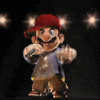
Mario is typically known as a plumber since Mario Bros., although he started as a carpenter in Donkey Kong. Although he is best known for being a plumber, the games rarely portray Mario being directly involved in plumbing. Other media, such as The Super Mario Bros. Super Show!, however, put a much bigger emphasis on Mario's job. According to the live-action segments in The Super Mario Bros. Super Show!, Mario works a menial job at Mario Brothers Plumbing in Brooklyn, just barely able to make enough money and sometimes complains about a dull life. Despite this, he and Luigi seem to excel at their jobs, as it is stated that they have one of the best plumbing in New York City. Also according to the show, Mario has received his plumber training from the Brooklyn Plumbers Academy, founded by Salvador Drainado, whom Mario holds to great respect. Mario is also skilled with various plumbing tools throughout the show's episodes, such as All Purpose Portable Plumber's Helper, Plunger and Plumber's Putty, which he uses to assist him and his friends in some hazardous situations.
In addition to plumbing, Mario has dabbled in various other occupations. One of his most notable recurring alternate careers is in medicine, as his alter-ego Dr. Mario, who stars in an entire spin-off series and is even a separate character in the Super Smash Bros. games. Mario is also known for his participation in a wide variety of spin-off sports games including, but not limited to golf, tennis, basketball, hockey, soccer and both kart and motocross racing. He also participates in a wide array of Olympic events and has even made a cameo as a referee in Mike Tyson's Punch Out!! Another subseries-specific recurring role Mario takes is as the president of the Mario Toy Company in the Mario vs. Donkey Kong games.
In addition to these, he has also had numerous one-off jobs, again including, but not limited to a demolition worker in Wrecking Crew, an archaeologist in Mario's Picross, a baker in Yoshi's Cookie, a factory worker in Mario's Cement Factory and Mario Bros. for the Game & Watch, a soldier who delivers bombs in Mario's Bombs Away, a grocery worker in Super Mario Bros.: Peach-hime Kyushutsu Dai Sakusen!, a psychotherapist in Super Mario Adventures (albeit as a gag), and potentially a sensei in Super Mario RPG: Legend of the Seven Stars. Finally, Super Mario Bros. & Friends: When I Grow Up depicts Mario in various occupations, intending to educate children on several careers they can explore.
Relationships
Family
Luigi is Mario's younger twin brother. Luigi often joins Mario on his adventures and the two of them are normally paired together in sports titles and spin-offs. They have a strong brotherly bond and will stop at nothing to help each other when one is in trouble, as seen in games such as Luigi's Mansion. It is stated in the 1993 official Nintendo Character Manual that Mario, when he retires, plans to give his plumbing business to Luigi (while also implying a distinct age contrast, which conflicts with the idea that they are twins).[16]
While they love each other, in Paper Mario, Luigi admits that he also feels jealousy towards his brother at times and has also expressed that he is "tired of being Player 2", for despite being a hero in his own right, he is often overshadowed by Mario. While Mario states that Luigi's quote of being Player 2 is taken out of context, adding that "Luigi loves being [his] sidekick" in the Mario Sports Mix press conference, in Mario & Luigi: Bowser's Inside Story, he is quick to give Luigi proper credit for defeating the Shroobs in the previous game. At times, Mario does exhibit a competitive sibling attitude toward Luigi, such as when he intentionally steps and squirms on Luigi's foot when Luigi receives a trophy in Mario Power Tennis. In volume 36 of Super Mario-Kun, he also apparently ditches Luigi when Luigi is trapped in the Star Gate, much to Luigi's dismay, only to return quickly to see Luigi break into tears. Overall, however he acts as a good brother and role model for Luigi.
The rest of Mario's family have not been extensively explored, especially outside the games. Mario and Luigi's supposed parents make a cameo at the end of Super Mario World 2: Yoshi's Island, although their faces are not seen and their names are not given, same as in their appearances in Family Album "The Early Years" and Super Mario Issun-bōshi. Furthermore, Yoshi's New Island has stated that these two are not Mario and Luigi's parents. The Super Mario Bros. Super Show!, on the other hand, mentioned or featured Mama Mario in a number of episodes, depicting her as a strict woman who loves her boys very much. Their father did not appear in the show and very little is known about him. The Super Mario Bros. Super Show! and the comics also make references or depict various other relatives of Mario, including aunts, uncles and cousins, although none have appeared in any games.
Friends and love interests
One of Mario's earliest friends is Yoshi, who, along with other Yoshis, saved him and Luigi from the Koopas when they are still babies. In Yoshi's New Island, Mario has also reciprocated by traveling to the past to help Baby Mario and Yoshi save Baby Luigi. In the present day, Yoshi continues to help Mario against Bowser, usually serving as his steed. Another good friend of Mario's is Toad, who occasionally goes on adventures with him, as in Super Mario Bros. 2, various Mario cartoons and the Nintendo Comics System, where he is seen to be Mario's loyal and trusted sidekick. Toad trusts that Mario will always save the day and even when not fighting alongside him will be quick to offer advice and encouragement. In Mario & Luigi: Partners in Time, Mario has also shown to be a caring parental figure over Baby Mario, but he also steps in if any of his teammates misbehave. Mario appears to enjoy the babies' company. When Baby Mario finally returns to the present, he gives Mario his hammer, showing his pleasure to be with his adult self.
Mario saves Princess Peach quite often and she usually rewards him with a kiss him upon her rescue and often bakes him cake as well. They share good chemistry in sports games and have been good friends since childhood. The German Club Nintendo comic "Warios Weihnachtsmärchen", it is even revealed that they spent their graduation ball in school together and in the official guide of Yoshi's Island DS, the description for the level Baby Mario and Baby Peach: Dynamic Duo states they have teamed up as babies to stop evil before the "romantic entanglements" of their adult lives. While both Mario and Luigi deny a relationship when Luvbi asks if Peach was Mario's "lady friend", Luvbi also comments that the princess "looms large in his regard" and then wonders if Mario had a "one-sided crush". Many other sources, however, do portray Mario and Peach as having an ongoing romantic relationship, such as the official European Mario website listing Peach as Mario's girlfriend and Mario Party 5 calling Peach and Mario's team "Cutest Couple".
Peach has not been Mario's only romantic interest, however. In the original Donkey Kong, Pauline was Mario's first girlfriend and damsel-in-distress, but while he still has to occasionally rescue her in the Mario vs. Donkey Kong series, the two are considered just friends now. In addition, when Mario saved Princess Daisy in her debut appearance in Super Mario Land, a heart appeared overhead, implying a romantic connection. This was never explored further, however and while Mario Party 4 gave them the team name "Nice Couple", most games link Daisy with Luigi instead, with her and Mario simply being friends, not even sharing any player chemistry in the Mario Baseball series.
Throughout his adventure, Mario has also befriended numerous characters, notably his partners in the Paper Mario series. His partners are loyal to him and some, such as Vivian, even have developed somewhat of a crush on him, whereas Ms. Mowz often flirts with him. Several other characters, especially in the Mario RPGs, including Toadette are also wooed by Mario's heroic antics, although Mario himself has shown little interest. Mario has also made friends with characters outside the Mario series. For instance, he teamed up with Kirby, Link and even Mega Man in the German Club Nintendo comics. Pit in Super Smash Bros. for Wii U even happily recalls his past adventure with Mario back in Super Smash Bros. Brawl and shows admiration for him and wants his autograph.
Foes and rivals
Bowser is Mario's arch nemesis and the two are locked in a neverending cycle of conflict. Bowser constantly tries to take over the Mushroom Kingdom and kidnap Peach and each time he upsets the peace, Mario stops at nothing to defeat him and set things right. Bowser often calls Mario a variety disparaging nicknames, especially in the cartoons. Mario sometimes returns the insults, but such retorts are usually restricted to the cartoons and other non-game media, since Mario is portrayed as silent, if not more cheerful and polite. When Mario does lose Bowser, he acknowledges it in good nature such as in Fortune Street, although he expects himself to be a competent adversary for Bowser. Occasionally the two team up to defeat greater evils, such as in Super Mario RPG: Legend of the Seven Stars, Mario & Luigi: Superstar Saga and Super Paper Mario and while Bowser openly hates Mario and resents him for his close relationship with Peach, for his part, Mario has never truly shown hatred nor contempt against Bowser and he is often more than happy to forgive Bowser after he defeats him, such as in Mario Party DS, where they enjoy playing Triangle Twisters together.
Bowser is not Mario's only foe, however and in the original Donkey Kong, it was Cranky Kong (then known as "Donkey Kong") that Mario had to defeat. The current Donkey Kong and Mario are on much better terms and often participate in sports and spin-offs together. Although they do maintain a friendly and somewhat competitive rivalry, Mario must defeat Donkey Kong a couple times in the Mario vs. Donkey Kong series because Donkey Kong went into mischief, stemming from his passion and frustration for Mini Marios and Mario's ex-girlfriend Pauline. Even after his victory, after noticing Donkey Kong upset, Mario reconciles by offering his toys.
Mario's main rival, however, is Wario. Various comics depict their antagonistic relationship starting in childhood and it is a major theme in the Super Mario-Kun manga. In Wario's first appearance, Super Mario Land 2: 6 Golden Coins, he stole Mario's castle and in Mario Super Sluggers, he tried to destroy Mario, although for the most part, their rivalry is far more mild in nature and the two even team up to defeat Bowser in Super Mario 64 DS. Nintendo Power has stated that Wario is Mario's cousin[citation needed], but this is unconfirmed. Finally, according to Wario in Wario's Warehouse, both Wario and Waluigi hang out with him, although Mario frequently peeks at Wario's Warehouse. Wario has shown mostly contempt for Mario, but he does not share the same level as dislike as Bowser, whereas Mario, although he has been initially bitter and even called Wario an "evil creep",[20] maintains his cheerful and positive attitude as he does with most of his enemies.
Mario appears to be friendly rivals with Sonic the Hedgehog, as the two have teamed up several times to stop Bowser and Dr. Eggman. They appear to be extremely competitive in sports and events, however, often trying to see who is faster. According to an informal conversation with Mario, Mario stated in response that he likes Sonic and views him as a friendly archrival than an enemy.[citation needed]
List of game appearances
This is a list of game appearances for Mario. Minor appearances, including cameos, are not counted.
Official profiles and statistics
- Main article: List of Mario profiles and statistics
Mario has consistently and frequently appeared in every game as a balanced player designed to be mastered easily. The only notable exceptions are the Mario Golf games, where he has a high drive, higher than most of the cast, including known-power characters such as Wario and Donkey Kong (in Mario Golf: World Tour, for instance, his drive is surpassed only by Bowser, Rosalina and Donkey Kong). Otherwise, since Mario is designed as a versatile character, his stats reflect the "jack of all trades" quality. In games where Mario's stats are not equally balanced, he generally leans slightly toward power. While Mario is fairly nimble in games such as Super Smash Bros., Mario Super Sluggers, the Mario & Luigi series and in the Mario & Sonic series, he is sometimes portrayed with average or even below-average mobility in other games including Mario Superstar Baseball, Mario Tennis games and Mario Strikers Charged.
Most bios have described Mario as a well-known icon in Mushroom Kingdom, Nintendo and in video gaming in general. They may also celebrate his numerous accomplishments or his previous forays.
Mario's most frequent associated color scheme has been red, although his scheme may sport blue or white motifs. His logo is his trademark M cap.
Portrayals
Mario has been voiced by the following people:
- Peter Cullen - Saturday Supercade
- Tōru Furuya - Super Mario Bros.: Peach-hime Kyushutsu Dai Sakusen!, Amada Anime Series: Super Mario Bros., Super Mario World: Mario to Yoshi no Bōken Land, Satellaview games.
- Lou Albano - The Super Mario Bros. Super Show!
- Walker Boone - The Adventures of Super Mario Bros. 3, Super Mario World
- Ronald B. Ruben - Mario Teaches Typing
- Takeshi Aono - Mario Paint commercial
- Bob Hoskins - Super Mario Bros.
- Marc Graue - Hotel Mario
- Nick Glaeser - Mario is Missing! (MS-DOS, CD-ROM Deluxe)
- Charles Martinet - Mario's Game Gallery - present
- Gorō Inagaki - 2003 "Hot Mario" commercial
- Takashi Okamura - 2005-2006 "Hot Mario Bros." commercials
- Kazunari Ninomiya - 2011 Super Mario 3D Land and Mario Kart 7 commercials
Gallery
- For this subject's image gallery, see Gallery:Sandbox.
- Mario MB.png
- Mario SMB.png
- Mariopaintart1.PNG
- PM Mario.gif
Quotes
- Main article: List of quotes by Mario
Games
- "Lets-a play!" - Mario Tennis: Power Tour/New Super Mario Bros. Wii/Super Mario 3D Land
- "It's-a me, Mario!" - Super Mario 64
- "Press Start to play." - Super Mario 64
- "Let's-a go!" - Various games
- "Here we go!" - Various games
- "Thank you so much for playing my game!" - Super Mario 64/Super Mario 64 DS/Super Mario Galaxy/Super Mario Galaxy 2
- Variations of "Mario time!" - Various games
- "Here I go!" - New Super Mario Bros.
- "That's so nice!" - New Super Mario Bros.
- "Mama mia!" - Various games
- "Yahoo!" - Various games
Mario comics
- Main article: List of quotes in Mario Comics § Mario
Mario cartoons
- The Super Mario Bros. Super Show!
- Main article: List of quotes in The Super Mario Bros. Super Show! § Mario
- The Adventures of Super Mario Bros. 3
- Main article: List of quotes in The Adventures of Super Mario Bros. 3 § Mario
- Super Mario World
- Main article: List of quotes in the Super Mario World television series § Mario
Names in other languages
| Language | Name | Meaning | Notes |
|---|---|---|---|
| Chinese | 瑪利歐 (Traditional) Mǎlìōu Template:Nowrap[21] Mǎlìōu |
Mario. This Traditional Chinese name is used by Nintendo in Hong Kong and Taiwan. Its simplified form, 玛利欧, was used by Mani (万信), Nintendo's former sale agency in mainland China before iQue.[22] Mario. The Simplified Chinese name is chosen by Shigeru Miyamoto and used by iQue, Nintendo's current subsidiary in China.[23] The unofficial name 马里奥 Mǎlǐào is also common.[24] |
|
| Dutch | Mario | - | |
| German | Mario | - | |
| Hebrew | מריו Mario |
? | |
| Italian | Mario | - | |
| Korean | 마리오 Mario |
Mario | |
| Portuguese | Mario | - | |
| Russian | Марио Mario |
Mario | |
| Spanish | Mario | - |
Trivia
- The 1993 Nintendo Character Guide classifies Mario under the species "homo[sic] nintendonus".[25]
- According to the Insiders' Calendar included in the second issue of Nintendo Power, Mario's birthday is October 11th.
- ^ http://www.guardian.co.uk/technology/gamesblog/2010/sep/13/games-gameculture
- ^ http://www.businesswire.com/news/home/20110531005315/en/Nintendo-DS-Lite-Suggested-Retail-Price-Drops#.UyJ5XYVI8UJ
- ^ http://videogames.yahoo.com/events/plugged-in/groundbreaking-hit-super-mario-bros-celebrates-25th-birthday/1410955
- ^ Cite error: Invalid
<ref>tag; no text was provided for refs namedGame On 2.0 - ^ Super Smash Bros. Melee (set to Japanese). The Mushroom Kingdom. (Retrieved May 29, 2010)
- ^ Griffin, A. (September 30, 2016) Mario is only 24 years old, creator Shigeru Miyamoto says in unearthed interview. Independent. Retrieved October 1, 2016.
- ^ http://kotaku.com/186665/five-foot-tall-mario-statue-for-sale The Japanese poster says "Life-size Mario!!"
- ^ IGN (Accessed on 7-6-09)
- ^ Barton, Jeff, Mario De Govia, Tri Pham, and Donato Tica. Mario Party 2 Prima Official Strategy Guide, page 5.
- ^ Stratton, Stephen, and Levi Buchanan. Mario & Luigi: Superstar Saga Prima Official Strategy Guide. Page 21.
- ^ a b http://www.youtube.com/watch?v=AAjhjLuWbC8
- ^ [1]
- ^ http://kotaku.com/5935721/super-marios-boss-doesnt-want-to-overdo-it-with-mr-video-game-and-wont-deceive-you-with-dlc
- ^ Cite error: Invalid
<ref>tag; no text was provided for refs namedfull name - ^ http://uk.youtube.com/watch?v=ZnSi7ihAhsQ Retrieved 28th July 2007
- ^ a b c Green, Matthew. (December 30, 2014). Mario, Kirby, And Samus Aran Shine In The Nintendo Character Manual. Press The Buttons. Retrieved February 16, 2016.
- ^ http://www.youtube.com/watch?v=eQVjYNE2Kew
- ^ http://www.youtube.com/watch?v=9ihWsOcbS_E
- ^ http://www.youtube.com/watch?v=atM5ZjqVVE4
- ^ Super Mario Land 2: 6 Golden Coins instruction booklet. "While I was away crusading against the mystery alien Tatanga in Sarasa Land, an evil creep took over my castle and put the people of Mario Land under his control with a magic spell. The intruder goes by the name of Wario. He has been jealous of my popularity ever since we were boys, and has tried to steal my castle many times. It seems he has succeeded this time. Wario has scattered the 6 Golden Coins from my castle all over Mario Land. These Golden Coins are guarded by those under Wario's spell. Without these coins, we can't get into the castle to deal with Wario. We must collect the six coins, attack Wario in the castle, and save everybody!"
- ^ iQue.
- ^ aquariuslegend (January 23, 2017). 万信国行初代GB 任天堂 GAME BOY 开箱. Chiphell. Retrieved February 5, 2017.
- ^ From an interview of iQue staff: "A:先提醒一下,宫本茂先生认为这位大胡子水管工的中文名称是马力欧,请大家尊重原创者的意见哈~" (A: First, Mr. Miyamoto thinks that the mustache'd plumber should be named "Mǎlìōu" in Chinese; please respect the original creator :) Retrieved January 28, 2017.
- ^ "不过由于「马里奥」在中国大陆由来已久,目前,中国大陆方面的通用译名为「马里奥」。" (But because the name Mali'ao has existed in mainland China for a long time, it is in wide use there now.) ~ Mandarin Wikipedia contributors. "马里奥 (角色)". Mandarin Wikipedia. Retrieved May 1, 2016.
- ^ Devore, Jordan (August 5, 2014). Yoshi is properly known as T. Yoshisaur Munchakoopas. Destructoid.
